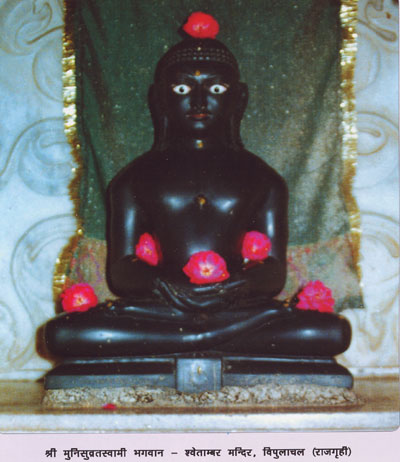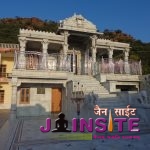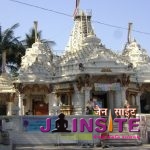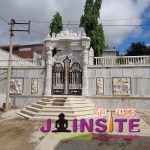SHRI RAJGRIHI TIRTH
PRESIDING DEITY AND LOCATION :
Mount Vipulachal : Sri Munisuvaratswami Bhagwan in black color, of height about 45cms (Shve). Sri Chnadraprabhu Bhagwan in white color of height 83 cms. (Dig).
Mount Ratnagiri : Sri Chandraprabhu Bhagwan in white color seated in a lotus posture (shve) , Sri Munisuvaratswami Bhagwan in black color, seated in a lotus poture ( Dig).
Mount Udaygiri : Foot-Prints of Sri Parshvanath Bhagwan (Shve), Sri Mahavir Bhagwan in almond color, in a standing posture (Dig).
Mount Swarnagiri : Foot- Prints of Sri Adinath Bhagwan (Shve), Sri Shantinath Bhagwan in black color, seated in a lotus posture. (Dig).
Mount Vaibhargiri : Sri Munisuruvatswami Bhagwan in white color, seated in a lotus posture (Shve), Sri Mahavir Bhagwan seated in a lotus posture (Dig)
All theses mountains are near the town of Rajagiri.
ANTIQUITY AND SALIENT FEATURES :
History of this ancient shrine begin from the time of 20th Tirthankar Sri Munisuruvatswami. This town in olden times was named Charankapur, Rishabpur, Kushagrapur, Vasumati Girivraj,Kshitiprathistha, Panchshail etc. Once upon a time there ruled in this city a king named Harivanshi Sumitra, whose wife was Padmavati. Due to auspicious time the queen had dreams on the night of Shravan Poornima indicative of the birth of a Tirthankar. At that very moment completing his earlier two incarnations, the soul of Sri Munisuruvatswami entered the womb of his mother to be. After the period of pregnancy was over, queen Padmavati gave birth to a son on Jyest Krishna Navami and as the queen during the entire period of her pregnancy had observed all Vrata’s (vows) like ‘munis’ (saints) the son’s name was called “Munisuruvat”. On attaining youth, “Munisuvrat” was married at the instance of his father king Sumitra to several princess including one named Prabhadevi. In the course of time Prabhadevi bore a son who was called “Suvrata”.
King Sumitra at this time renounced the world, entrusted the kingdom to Munisuvrat who in turn after several years of happy administration, one day having realized that the worldly life was of no importance, handing over the reigns of his kingdom to son Suvrata, also renounced the world giving all else belonging to him in charity through out the year. There were besides him one hundred kings who got initiated in the garden known as the Neelguha on Falgun Shukla 12.
After wandering as an ascetic for several years, he returned to the same garden and under a Champa tree remaining in austere meditation, he attained Keval Gnan on Falgun SHukla Krishna 12. (According to Digamber traditions, the birth of Sri Munisuvratswami was on Asoj Sukla 12, Diksha on Vaishakh Krishna 10 andKeval Gnan on Falgun Krishna 6.) This land thus became holy because “Panch Kalnayaks” of Tirthankars Munisruvat Swami took place here.
On this same Hari dynasty, after several kings, once there was Bruhdrath whose son Jarasangh was a brave and powerful king. His daughter Jivadyasha was married to king Kansa of Mathura who later was killed by Sri Krishna (Kansa was the maternal uncle of Sri Krishna) because he consistently behaved as a cruel tyrant to his subjects. King Jarasangh thus had serious grounds for revenge on the Yadava’s. He therefore attacked and invaded Mathura several times. The Yadava’s consequently feeling loathe to fight at last made an exodus to the west coast of the country and found the city of Dwarika. King Jarasangh however, did not leave Yadava’s in peace and continued to challenge them either to fight wars or to accept a feudatory position under him. In the result, both these armies indulged in heavy fighting. Only when the abhishekh water of the idol of Sri Shankeshwar Parshvanath was sprinkled on the armies, the battle died down, but finally Jarasangh was killed.
The city of Rajagrihi was then called Girivraj and Sri Krishna this became to be its Lord controlling the area. He handed over the control to the son of Jarasangh named Sahadeo but the prosperity of the area thereafter started to decline.
King Shrenik was at first a follower of Buddha but after his marriage with Chelana, the daughter of King Chetak of the kingdom of Vaishali, he became the follower of Jain religion and utilized all his energy and wealth and influence in propagating Jainism. King Shrenik was one of the important persons who listened to the sermons of Lord Mahavir. He participated in all Samosarans of the Lord and got his doubts fully resolved. As he was a generous and broad-minded king, preachers of all religions prevalent then made Rajagrihi the chief centre of their propaganda. During the reign of King Shrenik, Rajgrihi began prospering again and it became and established itself as an outstanding affluent city. Thousands of Jain were then the inhabitants of this city.
King Shrenik had three sons, Abhayakumar, Varisena, and Ajathashatru (also known as Kunika). The first two had renounced the world by becoming monks and Ajatashatru at the instigation of some rival religious leaders had arrested and imprisoned his father king Shrenik. Once when he realized his error he became extremely unhappy and sad and while in this mood being frightfully angry with himself he was rushing to the prison spot where his father was kept only to release him, the latter misjudging that the son was rushing to kill him, dashed his head countless times against the stonewalls of the prison and committed suicide. King Ajatashatru thereupon heavily repented and not being then able to bear the agony of repentance left the city of Rajagrihi and started living in a new city founded by him immediately in the name of Champanagari. In Jain scriptures, it is mentioned that King Shrenik because of his piety charity and religious zeal incurred Tirthankar Gotra on account of his numberless good and benevolent deeds will become the 1st Tirthankar (Padmanath) in the next set of 24 Tirthankars of the next cycle of time.
Ajatashatru was also a follower of Lord Mahavir. After him, came on the throne Sri Udayan who founded Patliputra.
During the time of kings SHrenik and Ajatashatru,Bhagwan Mahavir had visited these mounts on severa; occasions. References are available that during those visits he had come to Gunashil Chaitya Mount Vaibhargiri and mount Vipulagiri several times.
After King Udayan, it appears that Kharvel, the king of Kalling invaded the city and captured it. Later, in the middle ages as Buddhism was patronized by the kings, Buddhism spread here to a considerable extent. During ninth Vikram Century, king Aam of Kannauj attacked the city but was not victorious. At last his great grand son Bhoja Raja captured the city but thereafter the city once again stated do decline.
In the book “Vividh Tirthkalpa” written by Sri Jinaprabhasurishvarji inVikram year 1364, the city is fully described. In an inscription of Vikram year 1412, there is a mention about the construction of a temple dedicated to Sri Parshvanath Bhagwan by Deoraj and Vachcharaj, sons of Sri Mandana onMOunt Vipulgiri. A reference is available of Sri Shubhashila Genivarya having installed after due sanctification several idols here in Vikram year 1504. In Vikram year 1524 Sri Jitamalji of Srimal dynasty installed idols of Dhanna and Shalibhadra and Foot-Prints of eleven Ganadharas onMount Vaibhargiri after due sanctification. In 1657 Sri Jayakirtivijayji, in 1746 Sri Shilavijaiji and in 19th Vikram century Sri Amritdharmaagani composed Tirthmalas and in them this shrine is highly eulogized. Besides, in the literature of both Swetambars and Digambers this great shrine had been repeatedly mentioned.
Till date, countless pilgrim groups have visited this shrine and even now they continue to visit it. Except these pilgrims now, unfortunately there is in this area no population of Jains. At the present times, considering the needs of general public, there is a scheme being implemented called Veerayatan. At the base level of Mount Vaibhargiri. This is at the instance of Muni kavi Amarmuni of the Sthanakvasi jain Sect. Sadhviji Chandanaji is the chief administratrix. The object of this Veerayatan is arrangement of healthy and balanced constructive life. The complex is outlined to include centers of health, religious study and art, a library, a shed for rearing and maintaining cows and sheds for several small scale industries.
The four Kalnayaks of 20th Tirthankars Sri Munisuvratswami took place on this holy land. The chief listener of Bhagwan Sri Mahavir, Maharaj Shrenik, the Lord of Mahadha, brave, king and pious, who earned Tirthankar Gotra and will reincarnate as the 1st Tirthankar Sri Padmanaba Swami of the next set of 24 Tirthankars, of the next cycle of time happened to be living on this land. The eleven Ganadharas of Bhagwan Sri Mahavir, nine during his life time and two viz Gautamswamiji and Sudharmaswamiji after his Nirvana, attained their salvation here on Mount Vaibharagiri. One more belief is that all eleven Ganadharas attained Nirvana at Gunsheel. This was also the main place for Bhagwan Buddha. Here in the cave known as Sapta Prani, the first conference of Buddha saints was held and it is famous at first “Sangiti”. According to Digambers, Bhagwan Mahavir had delivered his first sermon after attaining Keval Gnan on Mount Vipulagiri on Shravan Krishna 1.
Indrabhuti Sri Gautamswami having been inspired by the first sermon of Lord Mahavir had become the first Ganadhar here. (According to Swetambers, the first sermon was delivered in Pavapuri). Bhagwan Mahavir spent fourteen chaturmasyas on this land and on account thereof the benefit that was derived by innumerable souls at that time on this land is just beyond any description.
This also happens to be the land where once upon a time lived great souls such as Sri Metaraj, Sri Arhabutta, Sri Dhanna, Sri Shalibhadra. Sri Meghakumar, Sri Abhaykumar, Sri Nandishena.Sri Arjunmali, Sri Kyavanna Sheth, Sri Jambu Swami, Sri Prabhash, Sri Shyambhusuri and Sri Punia Shravak whose tales are still sung and whose actions are still remembered by the Jains all over the world. All the dust particles of all these Mounts are therefore holy. At least once in a life time, a pilgrimage here is a “must” for all Jains.
A DAY ON THESE MOUNTS :
Walking a few steps from dharamshala at the base level, you come across hot water resovoirs. A little further away, the climb to Mount Vipulagiri begins. About 2Kms onward you reach the shrine on Vipulagiri where according to the Digambers Lord Mahavir’s first sermon was delivered. On this mount, there is a temple each of Swetambers and Digambers. A new temple is also under construction.
From here, descending almost 11/2 kms and again climbing equal distance you reach another Mount called Ratnagiri. This road of climb is a difficult one. Here also there is a temple each of Swetambers and Digambers. Opposite this Mount of Ratnagiri you see a large temple of Lord Buddha on Mount Grudhrakuta. It is believed that Lord Buddha had visited this spot several times and had delivered his sermons. From Ratnagiri Mount, 2Kms away you reach Gaya-Patna road and 1 Km further you climb to the third mount viz Udaygiri begins. The climb is more difficult and it is about 1.5Kms long. Steps are made there. There are both Swetambers and Digamber temples here and you have to descend the same way you have ascended. On the way you get sheltered drinking water facilities. On your left, the river Falgu flows as if washing the feet of the Mount and you reach the Dharamshalas almost 1.5 Kms away. From here the base level of the fourth Mount Swarnagiri (also knownas Shramangiri) is at a distance of 5Kms. The climb is another 2Kms. Steps are made here. Here too there are Shwetamber and Digamber temples, one each. From here about 2Kms away is a gymnasium of king Jarasangh. At a little distance onwards, the climb if the fifth Mount Vaibhargiri begins. There are total of 565 steps on the mount are Shwetamber and Digamber temples. A little on the left is the temple of Shalibhadra. It is believed that the 11th Ganadhar of Lord Mahavir attained Moksha here. On one side of this temple is a Jain temple in ruins where there are still many ancient idols of great art and beauty. The temple is believed to be of the 8thcentury. “Sapta Parni” cave from here is a few steps away where it is believed that the first conference of Buddha saints had taken place. On the eastern incline of the Mount there is a building of stone which is said to be the resting place of king Jarasangh. On the southern incline of this mount are two caves, one on the west and the other on the east. On the former cave, there is an inscription believed to be of the 3rd and 4th century. At first, there used to be in this cave an idol with 4 faces one in each direction. There is also a legend about this cave that here the gold-hoard of king Shrenik was hidden somewhere here. The name of the cave therefore still in vogue is”Swaran Bhandar” In the cave on the east are idols carved on the walls and this also is believed to be a cave to the 3rd or the 4thcentury. Descending further from here you come across hot water reservoirs which you have started is only 3Kms away.
In both Swetamber and Digamber temples at the base, there are ancient idols which are sight worthy. It is possible that the idols from the Mounts may have been brought here. The idols in the temple which is in ruins on Vaitharpuri Mount are superbly artistic. There are at present not being worshipped and therefore have been in charge of the archeological department of the Government. This temple is believed to be of the 8th century. Besides, Maniar Math which is also known as useless well is a place worthy of note. It is believed that the grand father of Sri Shalibhadraji used to send from his heavenly abode, for the benefit of his son and his 32 wives 33 cases of food, clothing and jewels every day and after making use of all these, they were thrown into this well. Bimbisar (Shrenik) prison is 1Km away from this Math, the prison where King Shrenik was kept as a prisoner by his son Ajathashatru. Hot water reservoirs are very ancient and they have been already described earlier. The resting place of king jarasangh,Sapta Parni caves etc, are all places worth a visit.
In Rajgir town situated at the base level of the Mount there are Swetamber and Digamber temples. On all the 5 Mounts, there are temples as described above and on the 5th Mount of Vaibhargiri there is one temple in ruins.
APPROACH – ROUTE :
The railway station of Rajgir is 2Kms away from Dharamshalas at the base levels and the bus stand is only 250 meters away from dharamshalas. Taxis and Rickshaws are available in the town. By road and rail line, Patna is 100kms away. Gaya by road is 65Kms and Bakthiyarpur by road and rail is 50Kms away from this shrine.
AMENITIES FOR JAIN PILGRIMS :
There are Shwetamber and Digamber Jain dharamshalas for lodging with all facilities and a bhojanshala etc., are available. Water is available at the temple on the Mounts. It is recommended that two days should be spent to complete the pilgrimage to all the five Mounts. The pilgrimage would be put to greater hardship.
Managed By :
Sri Jain Swetamber Bhandar
P.O Rajgir – 830 116.
Dist : Nalanda, (Bihar)
Tel : 06112- 55220
Sri Digamber Jain Siddhakshetra
Tel : 06112-55235.






